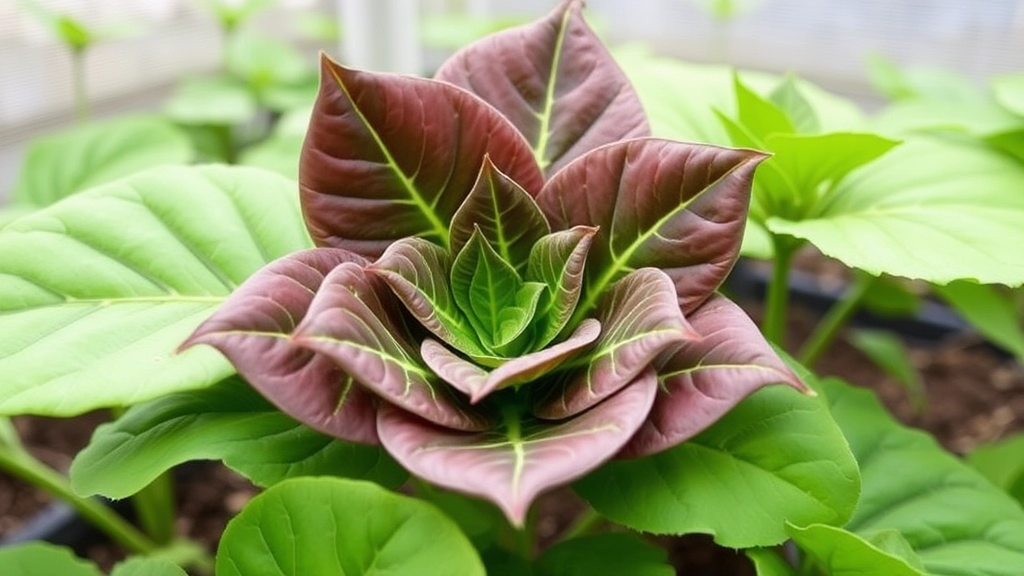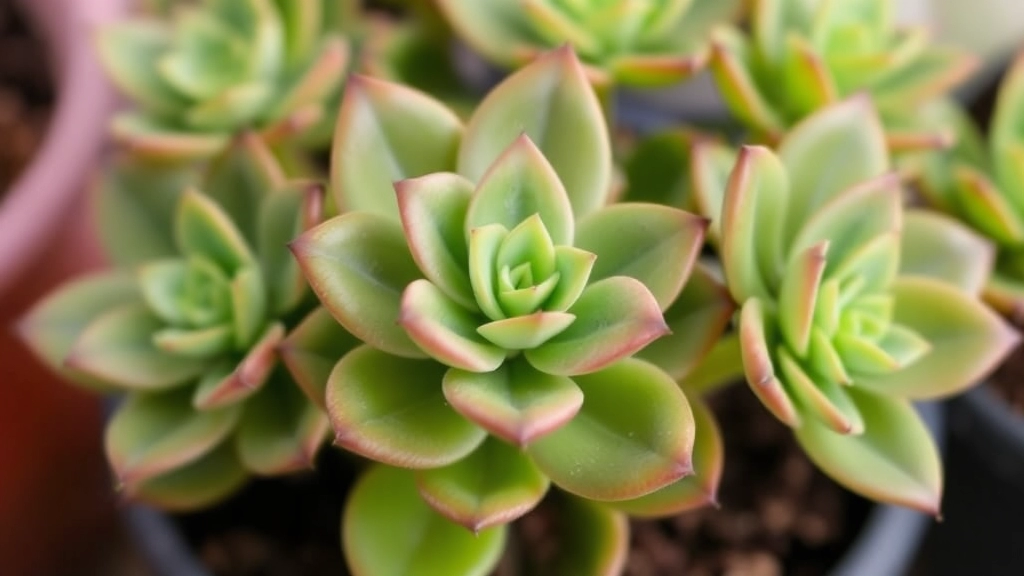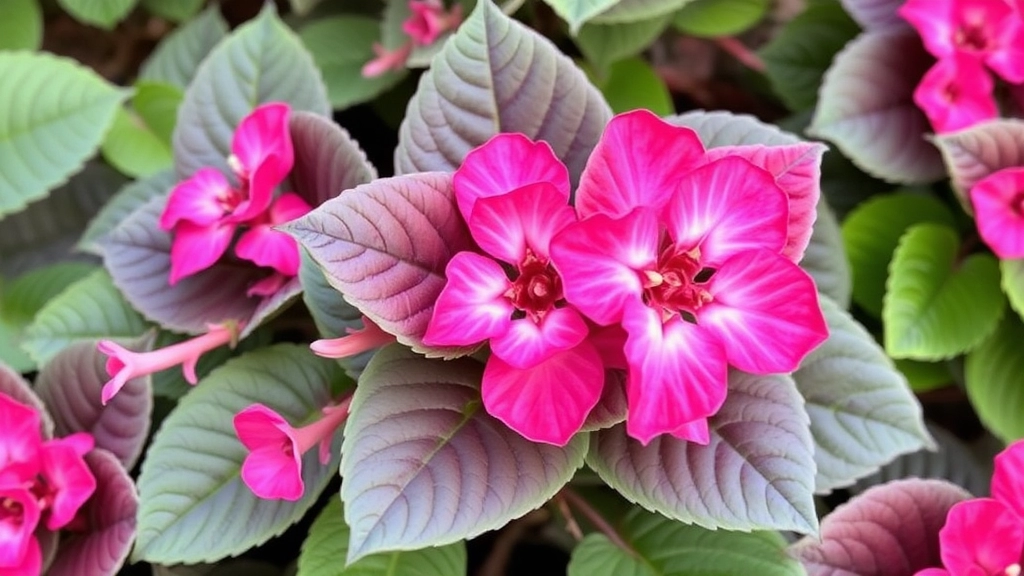Big Leaf Kalanchoe
Big Leaf Kalanchoe is a captivating plant known for its large, striking foliage. If you’re keen on identifying or growing this unique variety, you’re in the right place. Let’s dive into the key characteristics that make Big Leaf Kalanchoe stand out, from its distinctive leaves to its overall appearance.
Growing Conditions
Understanding the ideal growing conditions is crucial for thriving Big Leaf Kalanchoe. These plants love a balance of sunlight and shade, well-draining soil, and moderate watering. Whether you’re a seasoned gardener or a beginner, learning about the specific needs of Big Leaf Kalanchoe will ensure your plant flourishes year-round.
Key Characteristics of Big Leaf Kalanchoe
When considering houseplants, many people often wonder about the unique traits of various species. Big Leaf Kalanchoe, also known as Kalanchoe luciae, stands out due to its striking appearance and resilience.
Ideal Growing Conditions for Large-leaf Varieties

So, you’re keen on nurturing your Big Leaf Kalanchoe, huh?
Getting the right growing conditions is key to making sure your plant thrives.
Light Requirements
- Bright Indirect Light: These beauties love bright light but can’t handle harsh, direct sun.
- Filtered Sunlight: A spot near a window with sheer curtains works wonders.
Temperature Preferences
- Warm Temperatures: Aim for a cozy range between 20°C to 25°C (68°F to 77°F).
- Avoid Cold Drafts: Keep them away from chilly drafts or sudden temperature drops.
Humidity Levels
- Moderate Humidity: They prefer a bit of moisture in the air, but they’re not too fussy.
- Indoor Humidity: If your home is dry, consider a pebble tray or a humidifier.
Air Circulation
- Good Airflow: Ensure that your plant has decent airflow around it. This helps prevent pests and diseases.
Location Tips
- Indoor vs Outdoor: If you’re keeping them indoors, a bright room is best. For outdoor varieties, choose a spot with dappled sunlight.
Watering and Soil Preferences for Optimal Growth
When it comes to nurturing your Big Leaf Kalanchoe, understanding its watering and soil needs is crucial for thriving growth. You might wonder how to strike the right balance to keep your plant healthy and vibrant.
Watering Needs
Big Leaf Kalanchoe prefers a specific watering routine to flourish:
- Frequency: Water your plant every 2-3 weeks during the growing season (spring and summer).
- Soil Dryness: Always check the top inch of soil; if it’s dry, it’s time to water.
- Method: Water thoroughly until it drains from the bottom. Avoid letting the plant sit in water to prevent root rot.
Soil Preferences
The right soil mix plays a significant role in the health of your Kalanchoe:
- Drainage: Use a well-draining potting mix, ideally a cactus or succulent blend.
- Ingredients: A mix of peat, perlite, and coarse sand provides excellent drainage.
- pH Level: Aim for a slightly acidic to neutral pH (around 6.0 to 7.0).
By paying attention to these watering and soil preferences, you can create an environment that encourages your Big Leaf Kalanchoe to thrive. For more detailed care tips, check out our Kalanchoe Beharensis Oak Leaf Care Guide. Additionally, if you’re interested in expanding your collection, consider exploring the Different Kalanchoe Species for Your Garden.
Propagation Methods for Big Leaf Kalanchoe

When it comes to expanding your collection of Big Leaf Kalanchoe, understanding the best propagation methods is key. Many enthusiasts wonder how to successfully propagate these stunning plants without much hassle.
1. Leaf Cuttings
One of the simplest ways to propagate Big Leaf Kalanchoe is through leaf cuttings. Here’s how:
- Select a healthy leaf from the parent plant.
- Using a clean, sharp knife, cut the leaf at the base.
- Allow the cut leaf to dry for a few hours to form a callus.
- Place the leaf on well-draining soil, ensuring the cut end is in contact with the soil.
- Water lightly and place it in a bright, indirect light location.
2. Stem Cuttings
Stem cuttings can also yield excellent results. Follow these steps:
- Choose a healthy stem with several leaves.
- Cut the stem just below a leaf node.
- Remove the lower leaves to expose the stem.
- Allow the cutting to dry for a few hours.
- Plant the cutting in well-draining soil and water sparingly.
3. Offsets
Big Leaf Kalanchoe often produces offsets or baby plants. Here’s how to propagate using offsets:
- Gently separate the offset from the parent plant.
- Ensure that the offset has its own roots.
- Plant the offset in a small pot with well-draining soil.
- Water lightly and place it in a bright spot.
4. Seed Propagation
While not as common, you can propagate Big Leaf Kalanchoe from seeds. Here’s a quick guide:
- Obtain seeds from a reputable source.
- Sow seeds in a seed tray filled with a light potting mix.
- Keep the soil moist but not soggy.
- Place the tray in a warm, well-lit area.
### Common Issues and Solutions in Big Leaf Kalanchoe Care
Caring for Big Leaf Kalanchoe can be rewarding, but it’s not without its challenges. Many plant enthusiasts often encounter common issues that can hinder growth and overall health. Understanding these problems and their solutions is essential for maintaining a thriving plant.
#### 1. Overwatering
One of the most frequent issues with Big Leaf Kalanchoe is overwatering. This succulent prefers well-draining soil and can develop root rot if left in soggy conditions.
– **Signs:** Yellowing leaves, mushy stems.
– **Solution:** Allow the soil to dry out completely before watering again. If root rot occurs, remove the plant from its pot, trim away the affected roots, and repot in fresh, dry soil.
#### 2. Underwatering
Conversely, underwatering can also pose a problem. While these plants are drought-tolerant, they still require regular care.
– **Signs:** Wrinkled or shriveled leaves.
– **Solution:** Establish a consistent watering schedule. Water deeply, ensuring excess moisture drains away.
#### 3. Insufficient Light
Big Leaf Kalanchoe thrives in bright, indirect sunlight. Insufficient light can lead to leggy growth and poor flowering.
– **Signs:** Stretched stems, pale leaves.
– **Solution:** Move your plant to a brighter location, ideally near a window that receives filtered light.
#### 4. Pest Infestations
Pests such as mealybugs and aphids can occasionally invade your Kalanchoe, leading to stress and damage.
– **Signs:** Sticky residue on leaves, visible insects.
– **Solution:** Treat with insecticidal soap or neem oil. Regularly inspect your plant to catch infestations early.
#### 5. Nutrient Deficiency
Lack of nutrients can hinder the growth of your Big Leaf Kalanchoe, especially if it has been in the same soil for an extended period.
– **Signs:** Poor growth, discoloured leaves.
– **Solution:** Fertilise with a balanced, diluted succulent fertiliser during the growing season.
For more detailed information on caring for different Kalanchoe varieties, check out our [complete guide to Kalanchoe plant care](https://planthq.org/complete-guide-to-kalanchoe-plant-care/) and learn about the [causes and solutions for soft Kalanchoe leaves](https://planthq.org/why-are-my-kalanchoe-leaves-turning-soft-causes-solutions/).
Seasonal Care Tips for Indoor and Outdoor Growth
So, you’ve got your Big Leaf Kalanchoe thriving, but how do you keep it looking fabulous throughout the seasons?
FAQs about Big Leaf Kalanchoe
What light conditions are best for Big Leaf Kalanchoe?
Big Leaf Kalanchoe thrives in bright indirect light. They do well near a window with sheer curtains to filter the sunlight.
What temperature range is ideal for Big Leaf Kalanchoe?
These plants prefer warm temperatures between 20°C to 25°C (68°F to 77°F). It’s important to avoid exposing them to cold drafts or sudden temperature drops.
What humidity levels do Big Leaf Kalanchoe prefer?
They are comfortable in moderate humidity. If your indoor environment is dry, using a pebble tray or humidifier can help maintain the necessary moisture levels in the air.
How important is air circulation for Big Leaf Kalanchoe?
Good airflow is crucial for preventing pests and diseases. Ensure your plant has adequate air circulation around it.
Should Big Leaf Kalanchoe be kept indoors or outdoors?
They can be kept both indoors and outdoors. Indoors, a bright room is ideal. Outdoors, choose a spot with dappled sunlight.
What are the best propagation methods for Big Leaf Kalanchoe?
There are several effective methods to propagate Big Leaf Kalanchoe:
- Leaf Cuttings: Select a healthy leaf, cut it, allow it to callus, and then place it on well-draining soil.
- Stem Cuttings: Choose a healthy stem, cut below a leaf node, let it dry, and plant it in well-draining soil.
- Offsets: Separate offsets from the parent plant, ensure they have roots, and plant them in a small pot.
- Seed Propagation: Sow seeds in a light potting mix, keep the soil moist, and place the tray in a warm, well-lit area.
How do you propagate Big Leaf Kalanchoe using leaf cuttings?
Select a healthy leaf from the parent plant, cut it at the base, allow it to dry for a few hours to form a callus, and then place it on well-draining soil. Water lightly and keep it in a bright, indirect light location.
How do you propagate Big Leaf Kalanchoe using stem cuttings?
Choose a healthy stem, cut just below a leaf node, remove the lower leaves, allow the cutting to dry for a few hours, and then plant it in well-draining soil. Water sparingly.
How do you propagate Big Leaf Kalanchoe using offsets?
Gently separate the offset from the parent plant, ensure it has its own roots, plant it in a small pot with well-draining soil, and water lightly. Place it in a bright spot.
Is seed propagation common for Big Leaf Kalanchoe?
Seed propagation is less common but still possible. Obtain seeds from a reputable source, sow them in a seed tray with light potting mix, keep the soil moist, and place the tray in a warm, well-lit area.
References
-
Kalanchoe Care Guide – The Spruce
-
How to Propagate Kalanchoe – Gardening Know How
-
Kalanchoe: How to Grow and Care for Kalanchoe Plants – The Old Farmer’s Almanac
